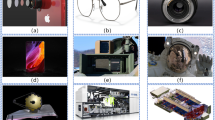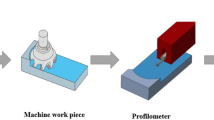Abstract
The processing efficiency of dentures is generally quite low due to the complex profile form and high brittleness of the dentures. However, there is little research for efficient path optimization and look-ahead speed control algorithm in denture machining field, which hinders the improvement of the machining efficiency and denture quality. In this work, an optimization method for both straight transition and curve paths was proposed, and look-ahead speed control algorithms for different machining paths were designed. The anomalous points were deleted according to the preprocessing algorithm before the path optimization. The straight transition path and curve path were fitted by the quasi-parabola model and cubic B-spline curve, respectively. The error between the optimized path and original path was analyzed, and the results demonstrated that the path optimization methods were reliable. A look-ahead speed control model based on S-type speed control was proposed, and the boundary conditions for different paths were calculated. The simulated and experimental results indicated that optimized algorithm significantly improved the machining efficiency and reduced the vibration of the machine tool. The accuracy and surface roughness of the denture processed using the optimized algorithm met the medical standard. This work can provide a theoretical guidance for high-efficiency and precision machining of dentures of glass ceramics.






















Similar content being viewed by others
Materials availability
The datasets supporting the results of this article are included within the article and its additional files.
References
Petersen PE (2008) World Health Organization global policy for improvement of oral health - World Health Assembly 2007. Int Dent J 58:115–121
Sun H, Jiang H, Du M, Wang X, Feng X, Hu D, Lin H, Wang B, Si Y, Wang C, Zheng S, Liu X, Rong W, Wan W, Tai B (2018) The prevalence and associated factors of periodontal disease among 35 to 44-year-old Chinese adults in the 4th National Oral Health Survey. Chin J Dent Res 21:241–247
Li C, Zhang F, Meng B, Liu L, Rao X (2017) Material removal mechanism and grinding force modelling of ultrasonic vibration assisted grinding for SiC ceramics. Ceram Int 43(3):2981–2993
Li C, Li X, Huang S, Li L, Zhang F (2021) Ultra-precision grinding of Gd3Ga5O12 crystals with graphene oxide coolant: material deformation mechanism and performance evaluation. J Manuf Process 61:417–427
Wu C, Pang J, Li B, Liang S (2019) High-speed grinding of HIP-SiC ceramics on transformation of microscopic features. Int J Adv Manuf Technol 102(5-8):1913–1921
Zhang F, Meng B, Geng Y, Zhang Y, Li Z (2016) Friction behavior in nanoscratching of reaction bonded silicon carbide ceramic with Berkovich and sphere indenters. Tribol Int 97:21–30
Li C, Li X, Wu Y, Zhang F, Huang H (2019) Deformation mechanism and force modelling of the grinding of YAG single crystals. Int J Mach Tools Manuf 143:23–37
Li H, Zhao Y, Cao S, Chen H, Qi H, Sun X, Li C, Liu G (2021) Controllable generation of 3D textured abrasive tools via multiple-pass laser ablation: parameter effects and selection. J Mater Process Technol 291:117050. https://doi.org/10.1016/j.jmatprotec.2021.117050
Chen J, An Q, Chen M (2020) Transformation of fracture mechanism and damage behavior of ceramic-matrix composites during nano-scratching. Compos A Appl Sci 130:105756
Li C, Wu Y, Li X, Ma L, Zhang F, Huang H (2020) Deformation characteristics and surface generation modelling of crack-free grinding of GGG single crystals. J Mater Process Technol 279:116577
Li Q, Wang C, Zhang Y (2019) Ultrasonic machining technology in dental materials. Diamond Abrasive Eng 39:112–122
Zeng K, Chen H, Shen J, Wu X, Lu L (2019) NC machining of axisymmetric aspherical glass lens with diamond grinding head. Diamond Abrasive Eng 39:103–109
Jackson MJ, Hyde LJ, Ahmed W, Sein H, Flaxman H (2004) Diamond-coated cutting tools for biomedical applications. J Mater Eng Perform 13:421–430
Tapie L, Lebon N, Mawussi B, Duret F (2015) Understanding dental CAD / CAM for restorations – accuracy from a mechanical engineering viewpoint Comprendre la CFAO pour les restaurations dentaire – la précision vue de l ’ ingénierie mécanique. Int J Comput Dent 18:343–367
Geng Y, Yan Y, He Y, Hu Z (2017) Investigation on friction behavior and processing depth prediction of polymer in nanoscale using AFM probe-based nanoscratching method. Tribol Int 114:33–41
Geng Y, Yan Y, Brousseau E, Sun Y (2017) AFM tip-based mechanical nanomachining of 3D micro and nano-structures via the control of the scratching trajectory. J Mater Process Technol 248:236–248
Borges CF, Pastva T (2002) Total least squares fitting of Bézier and B-spline curves to ordered data. Comput Aided Geom Des 19:275–289
Zhu D, Feng X, Xu X, Yang Z, Li W, Yan S, Ding H (2020) Robotic grinding of complex components: a step towards efficient and intelligent machining–challenges, solutions, and applications. Robot Comput Integr Manuf 65:101908
Lv Y, Peng Z, Qu C, Zhu D (2020) An adaptive trajectory planning algorithm for robotic belt grinding of blade leading and trailing edges based on material removal profile model. Robot Comput Integr Manuf 66:101987
Park H, Lee JH (2007) B-spline curve fitting based on adaptive curve refinement using dominant points. Comput Aided Des 39:439–451
Tsai MS, Nien HW, Yau HT (2010) Development of a real-time look-ahead interpolation methodology with spline-fitting technique for high-speed machining. Int J Adv Manuf Technol 47:621–638
Lin Z, Fu J, Shen H, Gan W (2014) An accurate surface error optimization for five-axis machining of freeform surfaces. Int J Adv Manuf Technol 71:1175–1185
Li JG, Zhang TH, Li ZX, Liu GF (2008) B-Spline fitting of continuous line segments in CNC machining. J Harbin Inst Technol 40:1606–1608
Zhang J, Zhang L, Zhang K, Mao J (2016) Double NURBS trajectory generation and synchronous interpolation for five-axis machining based on dual quaternion algorithm. Int J Adv Manuf Technol 83:2015–2025
Jin Y, Bi Q, Wang Y (2015) Dual-Bezier path smoothing and interpolation for five-axis linear tool path in workpiece coordinate system. Adv Mech Eng 7:1–14
Zhang L, Sun R, Gao X, Li H (2011) High speed interpolation for micro-line trajectory and adaptive real-time look-ahead scheme in CNC machining. Sci China Technol Sci 54:1481–1495
Zhao H, Zhu L, Ding H (2013) A real-time look-ahead interpolation methodology with curvature-continuous B-spline transition scheme for CNC machining of short line segments. Int J Mach Tool Manu 65:88–98
Sencer B, Ishizaki K, Shamoto E (2015) A curvature optimal sharp corner smoothing algorithm for high-speed feed motion generation of NC systems along linear tool paths. Int J Adv Manuf Technol 76:1977–1992
Tulsyan S, Altintas Y (2015) Local toolpath smoothing for five-axis machine tools. Int J Mach Tool Manu 96:15–26
Dong J, Wang T, Li B, Ding Y (2014) Smooth feedrate planning for continuous short line tool path with contour error constraint. Int J Mach Tool Manu 76:1–12
Liu Q, Liu H, Yuan S (2016) High accurate interpolation of NURBS tool path for CNC machine tools. Chin J Mech Eng 29:911–920
Liu X, Peng J, Si L, Wang Z (2017) A novel approach for NURBS interpolation through the integration of acc-jerk-continuous-based control method and look-ahead algorithm. Int J Adv Manuf Technol 88:961–969
Sun S, Lin H, Zheng L, Yu J, Hu Y (2016) A real-time and look-ahead interpolation methodology with dynamic B-spline transition scheme for CNC machining of short line segments. Int J Adv Manuf Technol 84:1359–1370
Annoni M, Bardine A, Campanelli S, Foglia P, Prete C (2012) A real-time configurable NURBS interpolator with bounded acceleration, jerk and chord error. Comput Aided Des 44:509–521
Luo F, Zhou Y, Yin J (2006) A generalized acceleration and deceleration approach for continuous small line blocks with look-ahead. J Wuhan Univ Technol 28:1052–1058
Chen Y, Ji X, Tao Y, Wei H (2013) Look-ahead algorithm with whole S-curve acceleration and deceleration. Adv Mech Eng 5:974152
Funding
This work was supported by the National Natural Science Foundation of China (Nos. 51875137 and 52005134), Natural Science Foundation of Heilongjiang Province of China (E2018033), and China Postdoctoral Science Foundation (2020M670901).
Author information
Authors and Affiliations
Contributions
Yong Zhang and Chen Li contributed in the idea and paper writing. Tao Wu and Jianxun Liu contributed in the algorithm design, grinding experiment, and paper writing. Yongfei Wang contributed in the grinding experiment. All the authors contributed in proofreading the manuscript.
Corresponding author
Ethics declarations
Ethics approval
Not applicable.
Consent for publication
We would like to submit the manuscript entitled “Investigation on path optimization and look-ahead speed control algorithm during numerical control grinding of dentures of glass ceramics,” for your consideration for publication in International Journal of Advanced Manufacturing Technology. No conflict of interest exists in the submission of this manuscript, and the manuscript is approved by all the authors for publication. On behalf of the co-authors, we declare that the work described was original research that has not been published previously and not under consideration for publication elsewhere, in whole or in part.
Competing interests
The authors declare that they have no conflict of interest.
Additional information
Publisher’s note
Springer Nature remains neutral with regard to jurisdictional claims in published maps and institutional affiliations.
Rights and permissions
About this article
Cite this article
Zhang, Y., Wu, T., Li, C. et al. Investigation on path optimization and look-ahead speed control algorithm during numerical control grinding of dentures of glass ceramics. Int J Adv Manuf Technol 113, 1899–1913 (2021). https://doi.org/10.1007/s00170-021-06707-1
Received:
Accepted:
Published:
Issue Date:
DOI: https://doi.org/10.1007/s00170-021-06707-1




